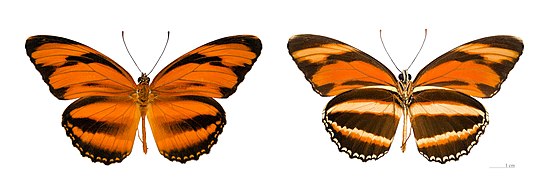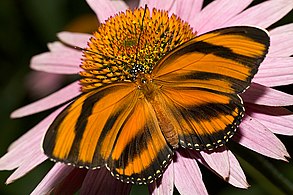
Summary
Dryadula is a monotypic genus of the butterfly family Nymphalidae. Its single species, Dryadula phaetusa, known as the banded orange heliconian, banded orange, or orange tiger, is native from Brazil to central Mexico, and in summer can be found rarely as far north as central Florida. Its wingspan ranges from 86 to 89 mm, and it is colored a bright orange with thick black stripes in males and a duller orange with fuzzier black stripes in females.
| Banded orange heliconian | |
|---|---|
| male, dorsal view Panama | |

| |
| female, ventral view | |
| Scientific classification | |
| Domain: | Eukaryota |
| Kingdom: | Animalia |
| Phylum: | Arthropoda |
| Class: | Insecta |
| Order: | Lepidoptera |
| Family: | Nymphalidae |
| Tribe: | Heliconiini |
| Genus: | Dryadula Michner, 1942 |
| Species: | D. phaetusa
|
| Binomial name | |
| Dryadula phaetusa | |
It feeds primarily on the nectar of flowers and on bird droppings; its caterpillar feeds on passion vines including Passiflora tetrastylis. It is generally found in lowland tropical fields and valleys.
This species is unpalatable to birds and belongs to the "orange" Müllerian mimicry complex.[1]
-
 male underside
male underside -
 female dorsal side
female dorsal side -
 pinned specimen (both sides) - MHNT
pinned specimen (both sides) - MHNT -
 female underside
female underside -
 pinned specimen (female dorsal side)
pinned specimen (female dorsal side)
Symbiosis edit
Prior to their mating season, males of this species congregate by the hundreds on patches of moist soil that contain mineral salts, a behavior known as mud-puddling. When they cannot find such deposits, the insects visit various animals to drink salty secretions from their skin and nostrils.[2]
Taxonomy edit
The genus Dryadula Michner, 1942, is monotypic; the type species is Papilio phaetusa Linnaeus, 1758 (Syst. Nat. 10 ed., 1: 478). The type locality, given as "Indiis", is supposed to refer to the West Indies or northern South America.
References edit
- ^ Pinheiro, Carlos E.G. (1996) Palatability and escaping ability in Neotropical butterflies: Tests with wild kingbirds (Tyrannus melancholicus, Tyrannidae). Biol. J. Linn. Soc. 59(4):351–365. HTML abstract
- ^ Richard Milner. (1999) Natural History 108(7):84–85.
- Dryadula phaetusa, Butterflies of North America, from the United States Geological Survey, Northern Prairie Wildlife Research Center.
External links edit
- Media related to Dryadula phaetusa at Wikimedia Commons
- Data related to Dryadula phaetusa at Wikispecies





